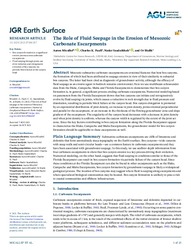The Role of Fluid Seepage in the Erosion of Mesozoic Carbonate Escarpments
DOI: https://doi.org/10.1029/2021JF006387
Persistent URL: http://resolver.sub.uni-goettingen.de/purl?gldocs-11858/9870
Persistent URL: http://resolver.sub.uni-goettingen.de/purl?gldocs-11858/9870
Micallef, Aaron; Paull, Charles K.; Saadatkhah, Nader; Bialik, Or, 2021: The Role of Fluid Seepage in the Erosion of Mesozoic Carbonate Escarpments. In: Journal of Geophysical Research: Earth Surface, Band 126, 11, DOI: 10.1029/2021JF006387.
 |
Dokument öffnen: |
Mesozoic submarine carbonate escarpments are erosional features that host box canyons, the formation of which had been attributed to seepage erosion in view of their similarity to subaerial box canyons. The latter had been cited as diagnostic of groundwater activity, although the efficacy of fluid seepage as an erosive agent in bedrock remains controversial. Here we use multibeam echosounder data from the Blake, Campeche, Malta and Florida Escarpments to demonstrate that box canyon formation is, in general, a significant process eroding carbonate escarpments. Numerical modeling based on parameters from the Florida Escarpment shows that box canyons can initiate and retrogressively evolve by fluid seeping via joints, which causes a reduction in rock strength due to fluid pressure and dissolution, resulting in periodic block failure at the canyon head. Box canyon elongation is promoted by an exponential distribution of joint density, an increase in joint density, joints oriented perpendicular and parallel to the escarpment, or an increase in the thickness of the flowing groundwater zone and slope gradient of the escarpment. The angularity of the canyon head decreases with a decrease in joint density and when joint density is uniform, whereas the canyon width is regulated by the extent of the joint set zone. Since the key factors contributing to box canyon formation along the Florida Escarpment appear to characterize the Blake, Campeche and Malta Escarpments, the groundwater model for box canyon formation should be applicable to these escarpments as well. Plain Language Summary:
Submarine carbonate escarpments are cliffs of limestone and dolomite that form anomalously steep topography on the Earth's surface. Box canyons—wide canyons with steep walls and semi‐circular heads—are a common feature in carbonate escarpments and they have been associated with groundwater seepage. In this study, we use seafloor depth information from four carbonate escarpments to show that box canyon erosion is a key process driving their evolution. Numerical modeling, on the other hand, suggests that fluid seeping in conditions similar to those of the Florida Escarpment can result in box canyon formation via periodic failure of the canyon head. Since these conditions at the Florida Escarpment can also be found in other escarpments such as the Blake, Campeche and Malta Escarpments, box canyon formation by groundwater seepage is likely a widespread geological process. The location of box canyons may suggest where fluid is seeping along escarpments and where specialized biological communities may be located. Box canyon formation is unlikely to pose a risk to coastal communities and offshore infrastructure. Key Points:
Box canyon formation is a significant erosive process across carbonate escarpments.
Fluid seeping through joints can drive initiation and retrogressive evolution of box canyons via periodic block failure at the canyon head.
Statistik:
ZugriffsstatistikSammlung:
- Geologie [931]
This is an open access article under the terms of the Creative Commons Attribution License, which permits use, distribution and reproduction in any medium, provided the original work is properly cited.

